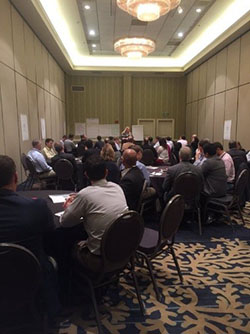
This year marked the 10th anniversary of the Frost & Sullivan New Product Innovation & Development MindxChange, and it was a great one!

If you’re unfamiliar with Frost & Sullivan, and their contribution to everything innovation, I can ensure you that they don’t throw your granddad’s event. This year was 3 days packed to brim with fantastic keynotes from top industry experts, killer seminars from some of the best thought leaders in innovation, and more networking with product innovation leaders and executives than you could find inside any four walls of a conference center.
If you did attend, I’m sure your mind is still aflutter with exciting ideas and best practices.
But if you weren’t lucky enough to spend a week of January in sunny San Diego, I’ve pulled together what I believe to be the 3 top key takeaways from this year’s show.
1. Creating the Environment for Innovation
It’s one thing to say you value innovation, but it’s another to actually cultivate the innovation capabilities needed to be successful.
Those of us in the product innovation community like to speak about the necessity to build a culture of innovation, but rarely do we dig into the steps needed to allow innovation to flourish.
Is your organization reaching out to various departments in the company to solicit help on innovation projects? Do you seek out feedback from your customers? What about competitors? To what extent is your company accepting of real failure? Have you developed an innovation and growth strategies?
It’s time to take innovation culture out of clouds and start breaking it down into real, core innovation capabilities to better assess your company’s innovation maturity.
2. Disruption Can Be Manufactured
One of the highlights of the conference was a keynote speech given by Doug Warner, VP of global innovation and New Business Incubation at HP.
He tackled another one of those often spoke of topics: disruption.
When we think of disruption, we think of start-ups. We think of the Ubers and Airbnbs of the world. But what if we could bring this type of disruptive innovation inside the enterprise?
Warner advocated for a change in mindset from large corporations. He argued that disruptive innovation might not be so hard to capture and iterate when attacked systematically, and that by building out the right infrastructure, large corporations can leverage their assets to bring about the type of big, disruptive innovation that leads to substantial return.
3. Open Your Innovation Boundaries
Open innovation, collaborative innovation, or whatever you want to call; we’re talking about it. Nothing seems to stir up that strange combination of excitement and fear than the idea of opening your product innovation process to the outside world.
Is it worth sharing your IP to accelerate and improve your ideas? What are the possible shortcomings of asking customers to help improve your product? And what are the implications of looking to your non-innovation staff to help facilitate new ideas?
I don’t think we figured out all the answers this year, but the discussion has started. And if the number of conversations I had on this topic are any indication, open innovation is something you’ll be hearing more and more about.
I hope these 3 takeaways provide a glimpse into some of the great content at last week’s show, and help you engage your own colleagues in some of these important discussions. And of course, we all hope to see you in San Diego next year!
Speaking of innovation, why not see how you rank against over 700 product development professionals across the globe who evaluated their innovation management maturity: Innovation Management Maturity Model – planview.com/immm




